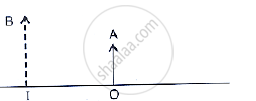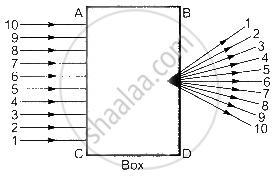Advertisements
Advertisements
प्रश्न
Complete the following table:
| Instrument | Number of Convex Lenses |
Use |
| Simple Microscope | .............. | .............. |
| Compound Microscope | .............. | .............. |
| Telescope | .............. | .............. |
उत्तर
| Instrument | Number of Convex Lenses |
Use |
| Simple Microscope | 1 | Used by watch repairers to view tiny watch parts |
| Compound Microscope | 2 | Used by watch repairers to view tiny watch parts |
| Telescope | 2 | Used to view faraway objects in outer space |
APPEARS IN
संबंधित प्रश्न
An object of height 2.5 cm is placed at a distance of 15 cm from the optical centre 'O' of a convex lens of focal length 10 cm. Draw a ray diagram to find the position and size of the image formed. Mark optical 'O', principal focus F and height of the image on the diagram.
An object is placed at a distance of 15 cm from a convex lens of focal length 20 cm. List four characteristics (nature, position, etc.) of the image formed by the lens.
When a ray of light enters from one medium to another having different optical densities it bends. Why does this phenomenon occur?
Where should an object be placed so that a real and inverted image of the same size as the object is obtained using a convex lens?
Draw a labelled ray diagram to show how a ray of light passes through a parallel sided glass block:
if it hits the glass block at an angle other than 90° (that is, obliquely to the glass block).
For what position of an object a real, diminished image is formed by a convex lens?
Fill in the following blank with suitable word:
Parallel rays of light are refracted by a convex lens to a point called the ........
Fill in the following blank with suitable word:
The image in a convex lens depends upon the distance of the ........... from the lens.
What type of lens is shown in the diagram on the right? What will happen to the parallel rays of light? Show by completing the ray diagram.
State whether convex lens has a real focus or a virtual focus.
A convex lens of focal length 8 cm forms a real image of the same size as the object. The distance between object and its image will be:
(a) 8 cm
(b) 16 cm
(c) 24 cm
(d) 32 cm
A burning candle whose flame is 1.5 cm tall is placed at a certain distance in front of a convex lens. An image of candle flame is received on a white screen kept behind the lens. The image of flame also measures 1.5 cm. If f is the focal length of convex lens, the candle is placed:
(a) at f
(b) between f and 2f
(c) at 2f
(d) beyond 2f
If the object is moved to a point only 3 cm away from the lens, what is the new position, height and nature of the image?
What type of images can a convex lens make?
What would be the diameter of the image of the flower on the film?
Which causes more bending (or more refraction) of light rays passing through it : a convex lens of long focal length or a convex lens of short focal length?
Complete the following sentence.
A long-sighted person cannot see ........... objects clearly. Long-sightedness can be corrected by using .............. lenses.
Show by a diagram the refraction of two light rays incident parallel to the principal axis on a convex lens by treating it as a combination of a glass slab and two triangular glass prisms.
A convex lens is placed in water. Its focal length will ______.
A lens forms an erect, magnified, and virtual image of an object. Name the type of lens.
The given below figure shows an object OA and its image IB formed by a lens
. 
draw suitable rays to locate the lens and its focus.
A student places a 8.0 cm tall object perpendicular to the principal axis of a convex lens of focal length 20 cm. The distance of the object from the lens is 30 cm. He obtains a sharp image of the object on a screen placed on the other side of the lens. What will be the nature (inverted, erect, magnified, diminished) of the image he obtains on a screen? Draw ray diagram to justify your answer.
If you are to determine to focal length of a convex lens, you should have
(A) a convex lens and a screen
(B) a convex lens and a lens holder
(C) a lens holder, a screen holder and a scale
(D) a convex lens, a screen, holder for them and a scale
For finding the focal length of a convex lens by obtaining the image of a distant object, one should use as the object.
(1) a well lit distant tree
(2) window grill in the class room
(3) any distant tree
(4) a lighted candle kept at the other end of the table.

i. Which type of microscope has the arrangement of lenses shown in the adjoining figure?
ii. Label the figure correctly.
iii. Write the working of this microscope.
iv. Where does this microscope used?
v. Suggest a way to increase the efficiency of this microscope.
Yesh find out F1 and F2 of symmetric convex lens experimentally then which conclusion is true.
A lens always forms an image between the object and the lens.
A lens always forms an image between the object and the lens.
A convex lens forms an inverted image of size same as that of the object which is placed at a distance 60 cm in front of the lens. Find: The position of image
An object 4.0 cm in size, is placed 25.0 cm in front of a concave mirror of focal length 15.0 cm.
(i) At what distance from the mirror should a screen be placed in order to obtain a sharp image?
(ii) Find the size of the image.
(iii) Draw a ray diagram to show the formation of the image in this case.
Point out the difference between a convex lens and a concave lens.
A concave mirror and convex lens are held in water. What changes, if any, do you expect in their focal length?
An object is placed in front of a convex lens such that the image formed has the same size as that of the object. Draw a ray diagram to illustrate this.
Can one bum a piece of paper in daylight by just using a convex lens instead of a match or any direct flame? Support your answer with the help of an appropriate ray diagram.
Observe the given figure and answer the following questions.

- Where is the above type of lens construction used?
- What type of image is formed by an objective lens?
- What happens instead of placing at Fo if the object is placed in between O and Fo?
A beam of light is incident through the holes on side A and emerges out of the holes on the other face of the box as show in the figure. Which of the following could be inside the box?

A convex lens of focal length 20 cm can produce a magnified virtual as well as real image. Is this a correct statement? If yes, where shall the object be placed in each case for obtaining these images?
Distinguish between:
Concave lens and Convex Lens
